Schedule a Call
Get started with your organic growth journey!



Get insights on AI, productivity, and the future of work.



If you’ve been thinking about starting a junk removal business, the first question that usually comes up is simple: “How much does it actually cost to get started?”
And it’s a fair question, because the numbers you see online can range from a few hundred dollars to tens of thousands, depending on who you ask.
The truth is, you don’t need a huge budget or a brand-new truck to enter this industry. What you do need is a clear understanding of the real costs, the optional costs and the hidden costs that most beginners only discover the hard way.
In this blog, you’ll learn the complete cost breakdown for starting a junk removal business, the price differences between lean and full-setup launches and the most efficient ways to spend and save your money in your first few months.
A junk removal business is a service that helps people clear out unwanted items quickly and responsibly. This includes old furniture, appliances, yard waste, renovation debris, garage clutter, estate cleanouts and anything else a homeowner or business can’t move or dispose of on their own.
These companies handle the heavy lifting, sorting, hauling and proper disposal or recycling. For customers, it’s a simple solution to reclaim space without dealing with the physical work, transport or local disposal rules.
A junk removal business sells convenience, speed and relief, and that’s why it continues to grow as more people look for fast, stress-free cleanouts.
Starting a junk removal business might look simple, but without a plan, it quickly becomes chaotic and expensive.
Here’s why it matters:
Launching a junk removal business requires understanding every cost you’ll face before your first job. These expenses don’t just determine your initial investment, but they shape your pricing, profitability, and how fast you can grow.

This section breaks down each core startup cost in simple, practical terms so you can budget confidently and avoid surprises:
Your vehicle is your office, billboard, and revenue engine.
What you might spend
Sources aimed at junk hauling show the truck/vehicle alone often sits around $20,000–$30,000 in a “typical” startup budget, before tools or branding.
What You Can Do:
You need to be legal and insurable from day one.
You Will Need:
One recent guide estimates permits and licences around $3,500 for a more formal setup, though many solo operators pay less if they keep it lean and local.
What You Can Do:
Junk removal touches people’s homes, driveways, and sometimes hazardous materials. One bad incident can wipe out your savings if you’re uninsured.
Common policies
Put combined liability + auto insurance in the $300–$800/year “starter” range for very lean setups, but expect to pay more as revenue, staff, or risk grows.
Points to Remember:
You don’t need a warehouse full of gear to start, but you do need enough to work safely and efficiently.
Core gear list:
For basic tools, you will need $600–$1,000, but for heavier equipments, it can go $6,000 plus, if you’re setting up more industrial or multi-service operations.
Budget range to plan:
Even in month one, you’ll pay to get rid of junk and keep your truck moving.
What To Expect:
Treat these as startup working capital, cash you keep in the bank so you can run jobs without stressing over every dump ticket.
A small, focused marketing budget up front can be the difference between a truck that sits and a truck that stays booked.
Key Requirements:
One detailed junk removal cost breakdown suggests $2,500 for initial marketing in a more fully built launch, while ultra-lean setups sometimes start with $50–$200 on basic promotion and scale as revenue comes in.
If you’re starting solo, this section might be small at first, but don’t ignore it if you plan to grow.
Startup Considerations:
Start lean, then build systems and people into your cost structure once revenue is predictable.
To make all of this less abstract, here are three simplified example scenarios. These aren’t quotes, just planning lenses to help you decide where you fit.
You already own a truck, work from home, and do most jobs yourself.
Estimated startup range: roughly $2,500–$6,000 cash needed to get moving.
Good fit if you want to test the market, keep your day job initially, or stay very local.
You’re committed to full-time, buying a decent used truck, and want to look established from day one.
Estimated startup range: Often $22,000–$40,000, depending on vehicle cost and how polished you go on branding.
Good fit if you want to compete seriously with the established players in your city.
You’re launching with staff, more than one vehicle, and dedicated yard/office space.
Estimated startup range: Easily $60,000–$150,000+, similar to some of the higher-end estimates you’ll see in industry guides that quote up to $300,000 for fully built-out multi-location operations.
This path is for operators with capital, experience, or backing, often aiming to own a whole region, not just a neighborhood.
When you think “startup cost,” it’s easy to only count what you spend before your first job. But some costs kick in fast and need to be baked into your planning:
The simplest safeguard: keep 1–3 months of operating expenses in reserve if you can. That cushion turns a broken alternator or slow month into an inconvenience, not a crisis.
You want to look professional without overspending. A few practical rules:
Starting a junk removal business doesn’t require franchise-level capital, but it does require clear eyes about the real costs. For your junk removal business startup cost will be shaped by the truck you choose, how polished you want to look on day one, and how fast you plan to grow.
Start with the numbers. Decide which launch level fits you. Then build a business that’s as solid and dependable as the service you plan to offer.

Industrial sales used to start with outreach. Today they start with research. Buyers don’t want pressure. They want clarity. They want proof. They want to feel confident in a partner long before they ever schedule a call.
This means the companies winning the best industrial sales leads are more helpful, more visible and more consistent. They show buyers what they know, how they work, and why their solutions matter.
Strong industrial leads are the result of intentional communication that meets buyers where they already are: learning, evaluating, and deciding. And your business can guide every step of that journey.
Lead generation in the industrial world involves identifying companies that genuinely need a new supplier or have an upcoming project. These buyers move slower than consumers and usually involve several people in the decision. They care about your capabilities, certifications, tolerances, and whether you can support them long term.
In this space, a lead is a buyer with a real technical need, a timeline, and the authority to move a project forward. Effective lead generation helps these buyers discover your capabilities early, understand what you can handle, and trust you enough to start a conversation or issue.

Industrial lead generation does three things for you:
Below are the methods that consistently attract the right kind of leads, the ones with defined needs and a high chance of becoming repeat customers.
Most industrial companies already have a product catalog or capabilities brochure. The problem is that it often sits as a static PDF, buried three clicks deep on the website.
To make your catalog generate leads:
When your catalog is easy to search and tied to RFQ or enquiry forms, it becomes a continuous source of qualified industrial sales leads, not just a reference document.
Industrial buyers and engineers spend a lot of time researching before they ever speak to sales. Your website should help them do that work.
Useful content that supports lead generation:
The more your website answers real technical questions, the more often you’ll earn contact from serious buyers.
Want a quick health check on your website? Drop it into our AI Analyzer and get instant insights to help turn more visitors into paying customers.
Video remains underused in manufacturing, yet engineers and buyers watch videos to understand processes, compare suppliers, and validate capabilities.
What to create:
Video builds trust faster than text. Seeing your machines, people, and process reduces perceived risk, especially for buyers sourcing a new supplier.
A generic “Contact us” form attracts everything from students to one-off prototype requests. Quotation forms and project enquiry forms let you qualify leads earlier.
To make forms work for you:
A focused prospect form helps your team decide which leads to call first and which to park or decline politely.
Industrial buyers rarely start on social media. They start on channels built for engineering and sourcing. Your job is to show up there with clear, technical information.
Places to consider:
If you invest time or budget in these channels, make sure your listings:
Treat each platform as a feeder into your own website and sales process, not as a disconnected listing.
GBP is one of the most overlooked sources of high-intent industrial sales leads, especially for regional manufacturers, fabrication shops, job shops, and machining companies.
What to do:
A strong GBP helps you appear when local engineers and buyers search things like “metal fabrication near me”, “precision machining supplier”, or “custom PCB assembly shop”.
Email still works in manufacturing, as long as it respects the receiver’s time and context.
Two main use cases:
To keep email effective:
Email becomes a lead generation tool when each message connects a real problem to a specific capability you can offer.
In manufacturing, a single account can represent years of revenue. That makes account-based thinking more practical than chasing random leads.
To align around key accounts:
The goal is not just more names in the database, but deeper engagement inside the companies that matter most to your growth.
Trade shows and webinars are expensive if they only deliver business cards. They are valuable if they feed into a structured follow-up process.
To make events generate industrial sales leads:
Think of events as concentrated lead generation moments. The real value is harvested in the weeks after, not only during the trade show marketing.
If you sell through distributors, reps, or integrators, they are also a source of industrial sales leads. But they need more than a logo and a price list.
Give partners tools that directly support lead generation:
When partners are equipped to explain where you fit best, you receive cleaner, better-qualified opportunities instead of mismatched requests.
Industrial purchasing rarely depends on one person. Engineers, procurement, quality, and operations all influence decisions. A multi-channel approach ensures your brand shows up at different stages of their process, even when they’re researching quietly.
How to use it effectively:
Multi-channel doesn’t mean “be everywhere.” It means showing up where your specific buyers already look for suppliers.
Without measurement, it’s easy to over-invest in channels that generate “activity” rather than revenue.
At a basic level, track:
You don’t need a complex dashboard to start; a simple monthly review with sales is enough to see what is bringing in leads worth quoting and what is not.
Not every enquiry deserves the same amount of time. Clear qualification criteria help your team focus on leads that can become profitable, repeat business.
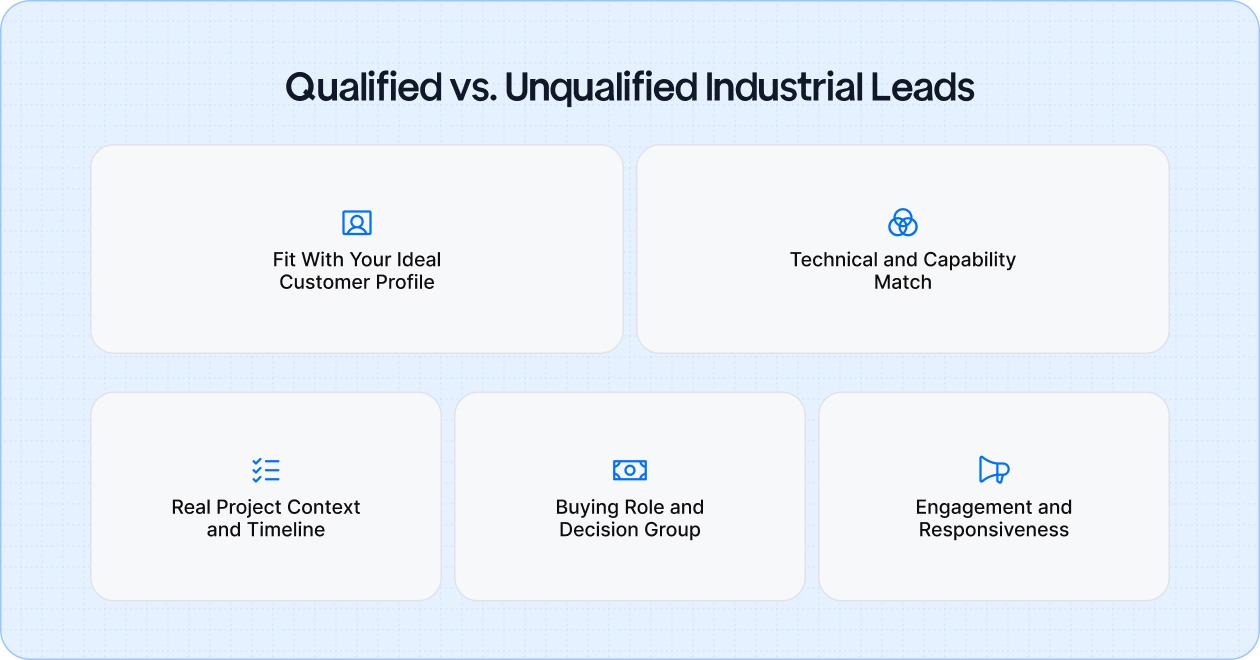
A qualified lead usually:
Non-qualified leads often sit outside your target sectors or require project sizes that are too small (or occasionally too large) for you to serve well.
Check whether:
If a lead needs something you have never done, or that would disrupt your core production, it may be better to decline or refer.
Qualified industrial sales leads usually come with a clear context:
Red flags include vague timing (“sometime next year”), no clear use case, or a request that appears purely exploratory with no identified project behind it.
In B2B manufacturing, the person who contacts you may be:
All can be valuable, but a qualified lead usually has visibility into the broader decision group or is willing to involve others. If a contact cannot explain who approves suppliers, who signs off on specs, or how sourcing decisions are made, treat it as early-stage until that clarity is gained.
Lead quality also shows up in behaviour:
If a prospect goes silent for weeks, refuses to share basic information, or only asks for “your best price” without dialogue, they may be more interested in price shopping than true partnership.
To make this practical, you can build a short checklist for every new lead:
If most answers are “yes,” you have a qualified industrial sales lead. If several are “no” or unclear, treat it as lower priority or nurture until it matures.
The companies that grow steadily are the ones that make it easy for the right buyers to understand what they do, see proof that it works, and start a focused conversation.
If you turn your catalog into a working asset, build flows that filter instead of flood, show up in the channels your buyers already use, and agree internally on what “qualified” really means, lead generation stops being guesswork. It becomes another well-run process in your operation, measured, improvable, and tied directly to the kind of business you want more of.

In the roofing business, the real work begins when you make sure people in your community know who you are and why they should choose you when their roof needs repair or replacement.
With storm damage, leaks, worn-out shingles, seasonal maintenance, and those unexpected roofing emergencies, homeowners are constantly searching for a reliable, trustworthy roofer.
But with so many options out there, how do you stand out? Let’s dive into 56 roofing marketing ideas that will help you connect with more clients, build your reputation, and grow your business in 2026.
A strong online presence is the foundation of any successful roofing business. With an optimized website, effective SEO strategies, and active business listings, you can increase visibility, attract the right customers, and build trust.

Here's how to create a website that attracts attention and converts visitors into loyal clients.
1. Clear, user-friendly design with easy navigation: Your website should be simple to navigate, allowing users to find information effortlessly.
2. Display your contact info and services on every page: Make sure your contact details are visible throughout the site to drive easy access for potential customers.
3. Show before/after photos and client testimonials prominently: Real-life proof of your work goes a long way in building trust with visitors.

4. Conduct keyword research personalized to roofing services (e.g., “roof leak repair near me”): Target search terms that your customers are using to find services like yours.
5. Optimize for local SEO by targeting location-based keywords (e.g., “roofing contractors in New York”): Make sure you’re visible for customers searching specifically in your area.
6. Use schema markup to enhance visibility in search results: Implement schema to help search engines better understand your business and improve your site’s visibility.
7. Build backlinks by collaborating with local businesses and organizations: Work with local businesses to exchange links, helping your site rank better.
8. Ensure your website is mobile-friendly for a seamless user experience: A mobile-friendly site ensures that visitors have a smooth experience no matter what device they use.
9. Claim and optimize both Google Business Profile and Apple Business Connect listings: Keep your information consistent across both to enhance your online presence.
10. Upload high-quality photos of your roofing projects: A picture is worth a thousand words. Showcase your work with professional photos.
11. Ensure your business details are accurate and up-to-date to prevent confusion and build trust with potential customers.
12. Respond to reviews to build customer trust by showing that you care about customer feedback.
13. Highlight your unique services on both profiles to stand out from your competitors in local searches.
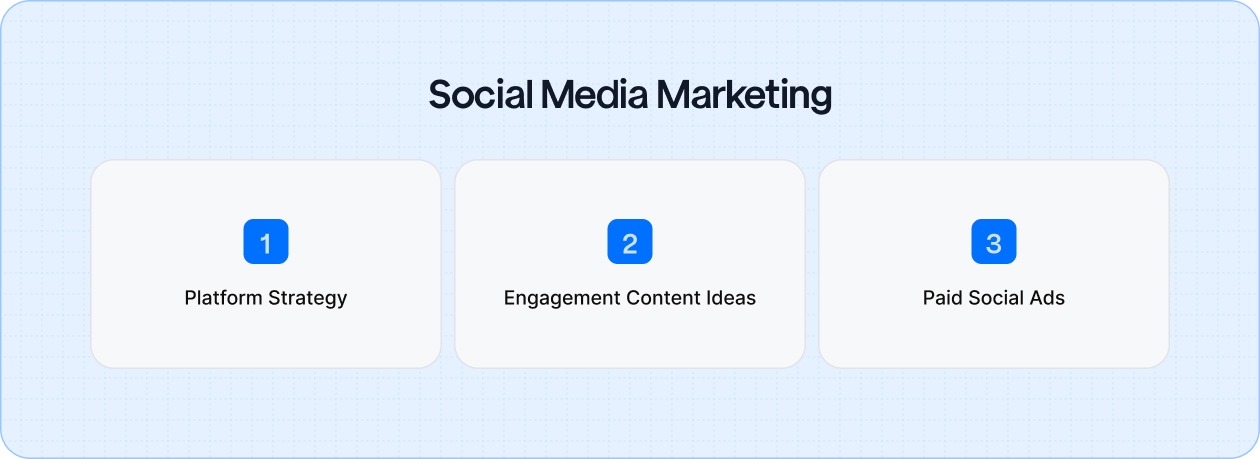
By creating engaging content personalized to different platforms and incorporating paid ads, you can increase your reach and show your community that you're the go-to expert for their roofing needs.
Here’s how to take your social media strategy to the next level and create a consistent, valuable presence online.
14. Focus on Facebook for local engagement with homeowners in your area: Connect with the local community and showcase your expertise.
15. Instagram for showcasing project photos, time-lapse videos, and customer testimonials: Visuals work well to capture attention and establish your authority.
16. TikTok for fun, behind-the-scenes roofing content and project reveals: Engage younger audiences with light-hearted, fun content showcasing your team and projects.
17. YouTube for educational roofing tutorials and project walkthroughs: Offer value to your followers with how-to guides and tips.
18. Share before-and-after photos of completed roofing projects: Show real results and let your work speak for itself.
19. Post roofing tips, maintenance advice, and solutions for common roofing issues: Educate your audience and position yourself as a helpful resource.
20. Go live to answer customer questions or show your roofing processes: Live interactions help to humanize your brand and build trust.
21. Share user-generated content (e.g., customers tagging you after a job completion): Let your satisfied customers spread the word.
22. Target Facebook ads to homeowners in your local area who need roof repairs or replacements: Focus on your community for a more personalized approach.
23. Use Instagram Stories ads to highlight limited-time promotions and specials: Create urgency with time-sensitive offers.
24. Run TikTok ads to showcase roofing projects and seasonal discounts: Reach a wider, younger audience while promoting your services.
Referral marketing is one of the most effective ways to grow your roofing business, turning satisfied customers into your best salespeople. By creating easy-to-use referral programs, partnering with local vendors, and tapping into third-party platforms, you can increase leads and expand your customer base without spending a fortune on advertising.
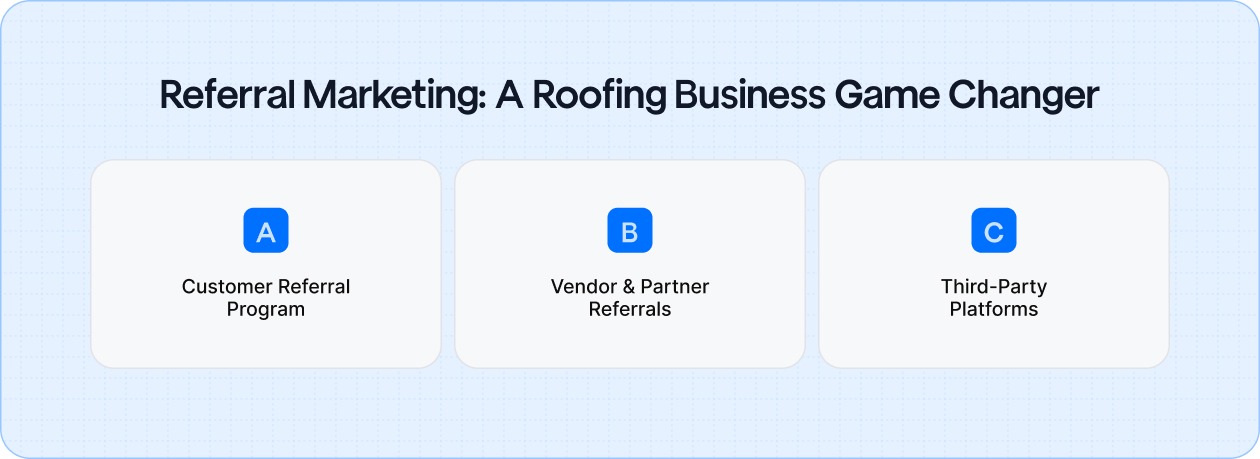
Here’s how to turn word-of-mouth into a powerful growth tool for your business.
25. Offer discounts or free services for successful referrals (e.g., free roof inspection): Incentivize your customers to spread the word and reward them for their loyalty.
26. Automate referral requests via text or email once a job is complete: Streamline the process and make it easy for customers to refer others.
27. Make it easy for customers to refer friends by using a simple system: Keep your referral process simple so that clients can easily share.
28. Partner with real estate agents for mutual referrals (e.g., roof inspections for homes on the market): Strengthen relationships with other local businesses for shared referrals.
29. Collaborate with insurance agents to get post-storm repair referrals: Insurance agents can be valuable partners for driving business after major weather events.
30. Work with other contractors (plumbers, electricians) to cross-promote services: Create win-win partnerships by referring customers to each other.
31. Get listed on platforms like Angi, Thumbtack, and Yelp to drive inbound leads: These platforms help you reach customers who are actively looking for roofing services.
Word of mouth and community engagement is one of the most authentic ways to generate new business. By tapping into local networks, sponsoring events, and offering personalized services, you can build strong connections and establish yourself as a trusted roofer in your community.
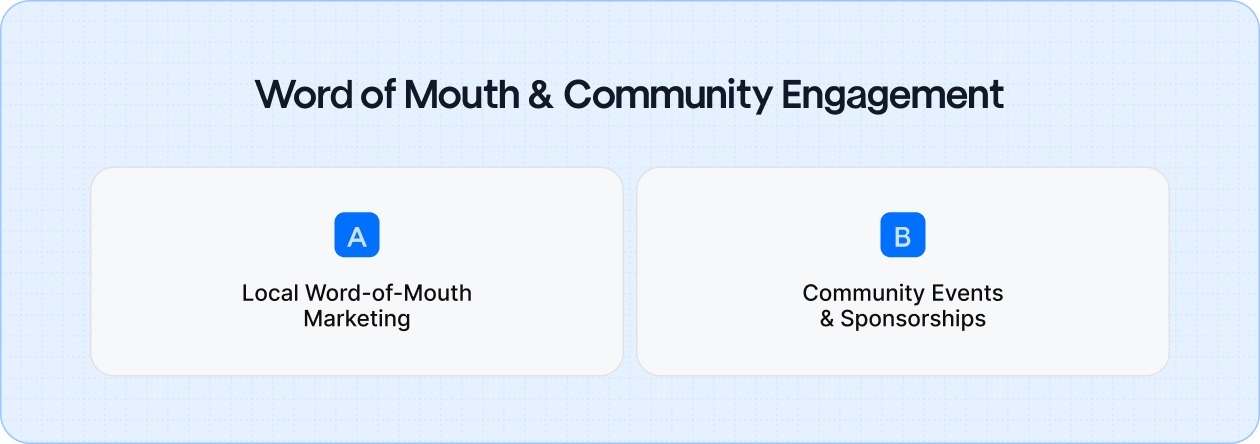
Here’s how to make the most of local marketing and community involvement to enhance your business.
32. Offer yard sign discounts to customers who let you place a sign on their property: A yard sign can advertise your business to neighbors and passersby.
33. Door-knock in neighborhoods that need roofing services (especially after a storm): Personalized outreach can make a significant impact, especially in post-storm areas.
34. Create a sales pitch that focuses on solving common roofing issues: Address the homeowner’s concerns directly to increase the likelihood of a conversion.
35. Attend local networking events to meet potential customers: Get involved in your community to increase your reach and build trust.
36. Use your vehicle as a mobile billboard with wraps or magnetic signs: Turn every trip into an opportunity to advertise your roofing services.
37. Sponsor local sports teams or school events to improve brand recognition: Show support for your community while marketing your services.
38. Host roof maintenance workshops or informational sessions at community centers: Provide value and educate homeowners while showcasing your expertise.
39. Participate in charity events and contribute to local causes to build goodwill: Demonstrate your commitment to the community while indirectly marketing your business.
Email marketing is a powerful tool for staying connected with your customers and keeping them engaged throughout their roofing journey.
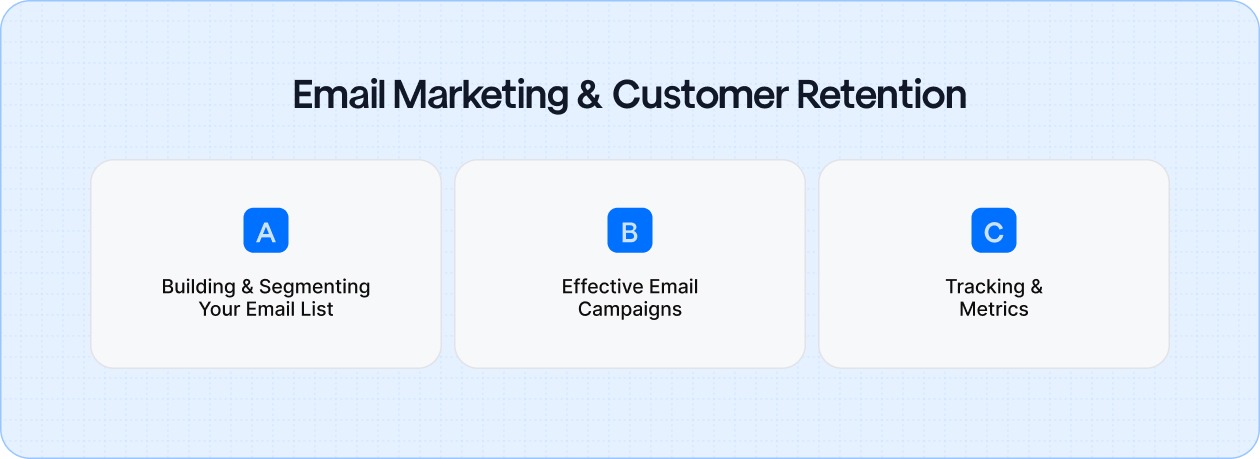
Here’s how to effectively incorporate email to retain customers and improve your marketing efforts.
40. Collect emails through website sign-ups and after-job consultations: Build your list early and keep customers informed about your services.
41. Incentivize sign-ups with discounts, free guides, or valuable content: Entice potential customers to subscribe with something valuable.
42. Segment your email list by customer stage (leads, completed projects, repeat clients): Personalize your content to where your customer is in their journey.
43. Send seasonal promotions, educational content, or roofing maintenance tips: Stay top-of-mind by offering timely and helpful emails.
44. Share customer success stories and project updates to keep clients engaged: People love real stories that showcase the work you've done and its impact.
45. Use automated email sequences to stay top-of-mind with previous customers: Automated campaigns help you nurture relationships and keep customers coming back.
46. Track open rates, click rates, and conversion rates to optimize email performance: Analyze performance and adjust strategies for better results.
Paid advertising and retargeting strategies are essential for reaching the right customers at the right time.
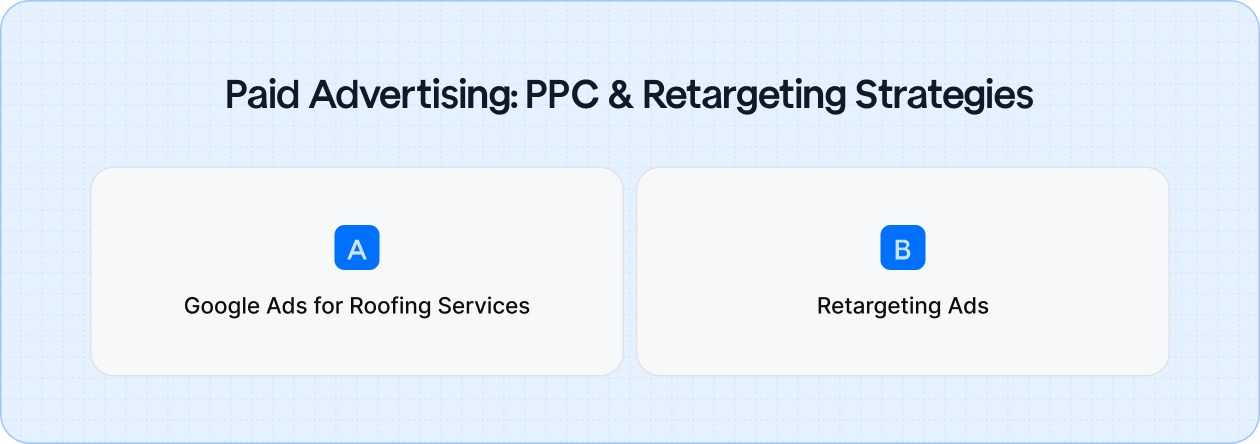
Here’s how to optimize your PPC and retargeting campaigns for the best results.
47. Use PPC ads targeting high-conversion keywords like “roof replacement near me” to capture customers actively searching for your services.
48. Use location-based targeting to focus ads on specific neighborhoods and ZIP codes: Narrow down on your service area to make sure your ads are reaching the right people.
49. Create separate campaigns for emergency roof repairs and routine maintenance: Segment your campaigns to ensure the right message reaches the right audience.
50. Monitor ad performance and adjust bids and copy for better ROI: Continuously improve your campaigns to maximize the return on your investment.
51. Set up retargeting ads to bring back website visitors who didn’t convert: Recapture interested visitors and turn them into customers.
52. Use dynamic retargeting to show personalized roofing service ads based on their previous actions: Display ads personalized to each individual’s interactions with your site.
Seasonal promotions and timely content can set your roofing business apart during key times of the year. By targeting specific needs like storm damage or seasonal maintenance, you position yourself as the trusted expert when customers need you most.

Here’s how to capitalize on these opportunities and keep your business top-of-mind all year round.
53. Offer a limited-time discount for roof inspections during the winter season: Attract customers who are preparing for the colder months.
54. Promote storm damage repairs immediately after major weather events: Be quick to respond to storm-related inquiries and position yourself as the go-to roofer in the area.
55. Run seasonal offers to encourage customers to book services before peak seasons: Create urgency with seasonal promotions to fill your schedule.
56. Share roof care tips specific to each season (e.g., how to prepare for winter storms): Help homeowners protect their roofs by providing seasonally relevant tips.
Must Read: Stop Running After Leads, Start Attracting Them: 10 Easy Roofing Tips
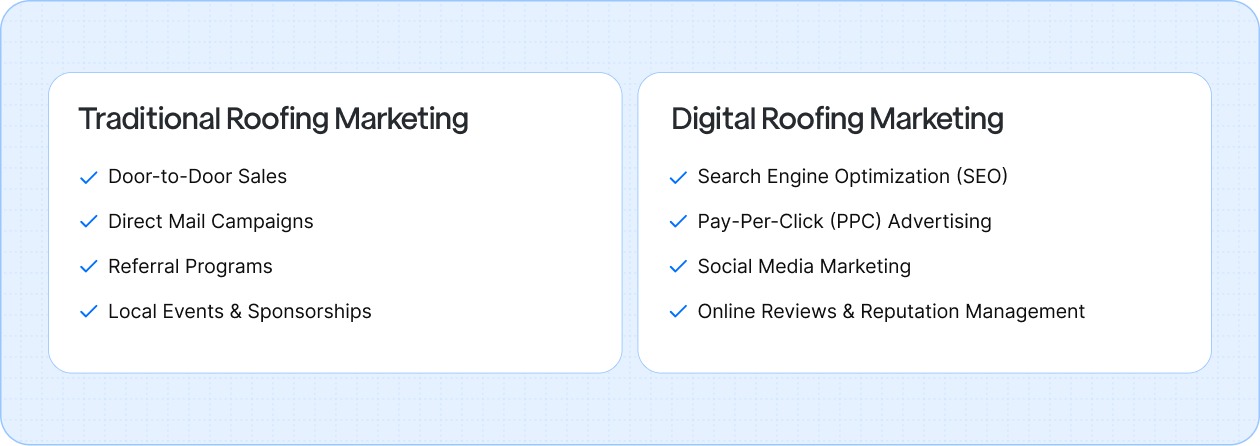
Traditional and digital marketing each offer unique ways to connect with potential customers and grow your roofing business. Here’s how you can use both strategies effectively in 2026.

AI is revolutionizing roofing marketing by automating tasks like content generation and SEO optimization, allowing you to target the right audience more effectively. With tools like lead scoring and predictive analytics, you can make smarter, data-driven decisions that maximize your ROI and streamline your efforts.
With the 56 roofing marketing ideas shared in this guide, you now have the tools to enhance visibility, generate leads, and build long-term relationships. Gushwork’s AI-powered SEO and content solutions simplify your marketing, so you can focus on growing your business.

Some contractors think they have a marketing problem. Most actually have a visibility problem. People in your city are already searching for someone who does exactly what you do, at the exact moment you’re reading this. The real issue is simple. They’re finding someone else first.
Lead generation in 2026 is about showing up clearer, faster, and more credibly than the next contractor.
In this blog, you’ll learn the strategies that help contractors get chosen first, why old tactics fail, and how to build a lead flow you can rely on week after week.
Contractors today face a very different market than they did even five years ago.
The basics haven’t changed: people want someone they trust, at a fair price, who will show up and do the job properly. What has changed is how they decide that.
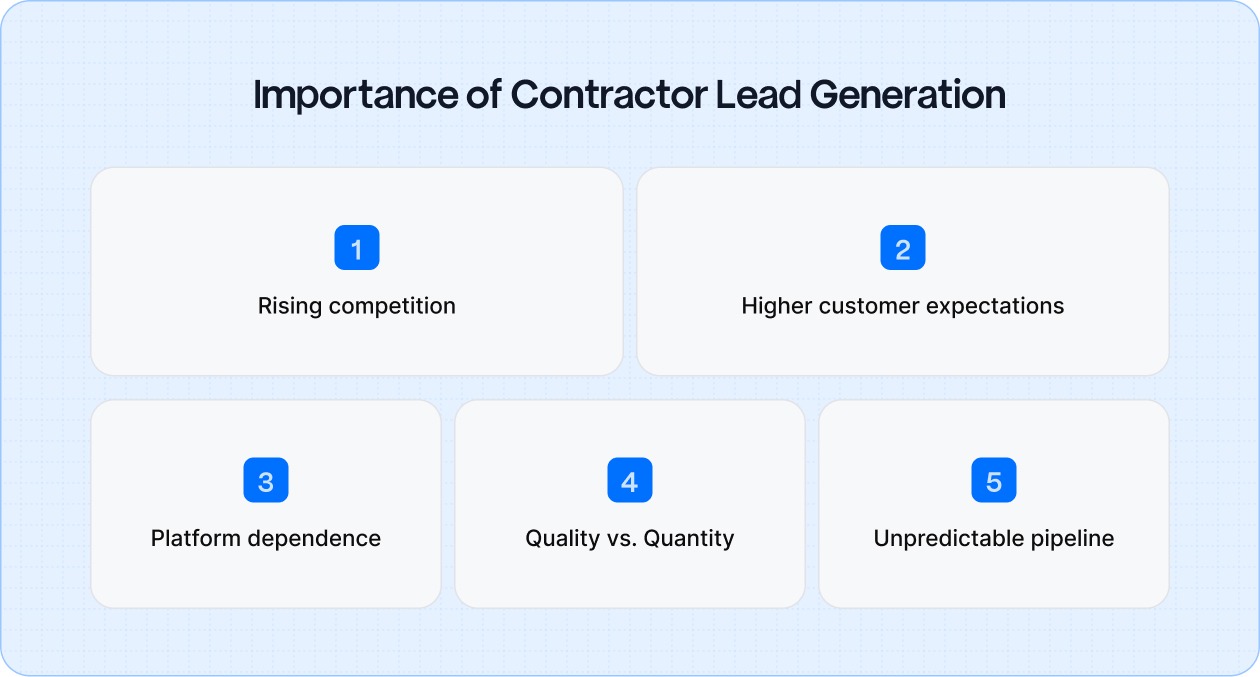
Here are the biggest challenges contractors face:
Effective lead generation solves these challenges by helping the right customers find you, trust you, and choose you, before they ever speak to another contractor.
There are hundreds of tools and lead vendors out there, but only a handful consistently help contractors turn marketing spend into booked work.
Below is a practical rundown of the best contractor SEO services for lead generation right now, what they’re good at, and when they make sense in your mix:
Gushwork is a hands-on marketing partner for contractors and industrial companies that want a proper pipeline. The focus is on building a system: website, SEO, PPC, GBP, tracking, and reporting that fits how you actually sell jobs.
Why Gushwork is the Top Choice?
How it helps with contractor lead generation:
Scorpion is a large marketing platform that focuses heavily on home services contractors (roofing, HVAC, plumbing, law, etc.). They offer websites, SEO, paid ads, chat, and basic CRM tools under one roof.
What Scorpion offers
Scorpion’s strength is scale and packaged solutions. That can be helpful if you want “most of it handled” quickly, but it may feel less flexible for contractors who want more tailored strategies or smaller, experimental campaigns.
Blue Corona works mainly with home service companies (HVAC, plumbing, electrical, remodeling), with a strong emphasis on tracking and analytics.
What Blue Corona offers
They tend to work best with contractors ready to invest consistently in marketing and who care about detailed reports and long-term compounding gains.
WebFX is a large digital marketing agency that serves many industries, including contractors and home services. They’re known for a wide service menu and strong technical SEO capabilities.
What WebFX offers
WebFX is a good option if you want a broad digital program (SEO + content + paid) and you’re comfortable working with a larger, systematised agency rather than a niche trade-only shop.
Contractor Dynamics focuses heavily on roofing and some exterior trades. They combine training, coaching, and done-with-you marketing to help instead of acting as a pure “done-for-you” agency.
What Contractor Dynamics offers
This is a good fit if you want to build internal marketing muscle and keep more control, rather than fully outsourcing all lead generation.
RYNO works mainly with HVAC, plumbing, and related home services. They position themselves as a performance-oriented agency that understands seasonality, call volume swings, and service-area constraints.
What RYNO offers
RYNO tends to work with contractors who already have some scale and are ready to push harder on growth with performance expectations.
There are also mid-sized agencies like Thrive and other regional firms that focus on contractors in specific geographies or niches.
What these agencies offer
Quality and fit can vary a lot at this tier. It’s worth asking for examples in your trade and region, plus clear reporting on cost per lead and booked jobs before you commit.
Here’s a simple, modern playbook that works across roofing, remodeling, plumbing, HVAC, electrical, landscaping, and other local trades:
Local listing sites (HomeAdvisor, Yelp, Angi, Thumbtack, Nextdoor, Houzz) still play a role because homeowners use them as discovery platforms. Being present gives you additional visibility beyond Google.
How to do it:
Your GBP is your single most important digital asset. It influences map-pack rankings, call volume, and local trust.
How to optimise it:
LSAs place you at the very top of Google for high-intent searches (“contractor near me,” “roof repair,” “kitchen remodel”). You pay per lead, not per click, making it one of the most reliable contractor lead channels.
How to get the most from LSAs:
Google Ads still generate some of the best contractor leads, if you avoid wasted clicks.
What works:
Contractors win big when happy customers do the selling. A good referral program turns past jobs into future revenue.
How to set it up:
AI-enhanced systems help contractors respond faster and keep conversations alive even when you’re on a jobsite.
What to use:
Homeowners trust the contractor who educates instead of hard-sells. Lead magnets work because they filter serious buyers from browsers.
Ideas that convert:
Offline presence still matters in trades. People trust contractors they see in familiar spaces.
What to do:
Direct mail is still powerful for contractors who work geographically. It’s tangible, hyper-local, and pairs well with digital follow-up.
Best use cases:
Homeowners search for cost clarity before anything else.
Pages like “Cost to Install a New Deck in [City]” or “Bathroom Remodel Cost Breakdown for 2025” consistently attract high-intent visitors who are actively budgeting.
Most contractors avoid these pages, which is why they work so well.
Homeowners often collect multiple bids and get overwhelmed.
Create a simple offer: “Upload your existing quote, we’ll review it for free to make sure it’s fair.”
This positions you as a trusted expert, which frequently leads to winning the project.
Not long PDFs — simple 150-word snapshots:
These build enormous trust and give homeowners a real sense of what you can deliver. Post them on your website, GBP, and social media.
Contractors lose tons of business simply by missing calls while on the job.
A missed-call text system replies automatically: “Hey, this is John — sorry I missed your call. How can I help?”
This saves dozens of leads per month, especially during peak season.
Choose a single job each week and create:
Use it across email, GBP, and social to stay memorable.
Homeowners often search a competitor’s name when they’re close to making a decision. Bidding on those terms gives you a chance to appear beside that competitor without being negative or misleading. The goal is simple: offer clarity, not confrontation.
Instead of trying to “steal” customers, position your ad as a helpful checkpoint before they commit.
Why this angle works: It meets homeowners at a natural point in their research, when they want reassurance they’re making the right choice. You’re not undermining the competitor. You’re giving the homeowner a reason to double-check, which often turns into a conversation you wouldn’t have gotten otherwise.
Finding the right contractor lead generation service can feel overwhelming, especially when every platform promises “high-quality leads” and “instant results.” But not all lead providers understand how projects actually move: slow bids, long approval chains, multiple stakeholders, and high job costs.
Use the checklist below to evaluate any lead generation company before signing up:
1. Lead Quality: Do they filter by project type, budget, location, and timeline? Are leads exclusive?
2. Exclusivity & Territory Protection: How many contractors receive the same lead? Do they cap competition in your area?
3. Industry Specialization: Do they understand your trade and match you with the right job categories?
4. Transparent Lead Sources: Are leads from SEO, PPC, LSAs, or resold third-party lists?
5. Lead Verification: Do they validate phone numbers, emails, locations, and readiness?
6. Cost Structure & ROI: Is pricing per lead, per month, or per booked job? Is ROI easy to measure?
7. CRM Integration: Do they plug into Jobber, ServiceTitan, HubSpot, or your follow-up systems?
8. Support & Dispute Handling: Do they credit bad leads quickly and respond to issues fast?
9. Reputation & Proof: Are there real contractor reviews and case studies showing revenue outcomes?
10. Scalability: Can you add zip codes, pause volume, or expand as your crews grow?
11. Data Ownership: Do you own the customer list, and can you export it anytime?
12. Job-Type Alignment: Do they send leads that fit your capabilities, crew size, and service offerings?
Your next step is simple: put one strong system in place at a time. Every improvement, better visibility, stronger messaging, faster responses, brings you closer to a business that runs on consistency rather than chance.
If you’re ready to turn “hope the phone rings” into a genuine growth engine, now is the time to act. Let’s build a lead generation system that supports your business every single day.

If you run a laser cutting business, you know how crucial all the small details are. One wrong measurement, one slightly incorrect setting, and the whole project is ruined.
So why is it that so many laser cutting shops still use a super simple "Name, Email, Tell Us Everything" form? When a potential customer visits your site, they want a quote for a specific job, they know their material, their thickness, and they have a file.
If your form doesn’t ask for the right requirements up front, strong prospects slip away and your team loses time sorting through incomplete or unusable submissions.
In this blog, we’re going to talk about how to fix that. We'll show you how to build a smart, simple lead form that asks the right questions in the right way.
A laser cutting lead generation form is the page or pop-up on your website where potential customers submit project details so you can quote or follow up. It’s usually the bridge between “I’m browsing” and “I’m ready to talk about a part or project.”
For a laser cutting or fabrication shop, this form serves as a part intake form, a sales filter, and a quoting shortcut.
A high-performing laser cutting lead generation form filters, qualifies, and accelerates quoting. Optimize the experience, and your form becomes a revenue engine instead of a basic contact page.
Many buyers abandon forms because they’re overwhelmed at the first step. Instead of showing every question at once, use conditional logic to reveal details gradually.
How to execute this:
This keeps serious engineers engaged and prevents casual requesters from quitting early.
Leaving fields fully open-ended leads to vague submissions like “metal, 3-ish mm?” or “steel plate.” Structured dropdowns improve accuracy and speed.
How to execute this:
This minimizes clarification emails and supports faster quoting.
If your upload tool is clunky, slow, or rejects standard part files, you’ll lose high-value leads instantly.
Best practices:
Add a clear line: “Don’t have CAD files? Upload photos or sketches and we’ll help evaluate options.” This keeps hobbyists and prototype customers from bouncing.
Not every form submission deserves the same response time. A few smart questions help your team rank leads.
Examples:
These inputs improve workload planning and help route enterprise accounts to sales instead of general support.
Short explanatory text near fields increases completions and decreases confusion.
Helpful microcopy examples:
Small explanations reduce anxiety and increase trust.
Engineers and purchasing teams often browse supplier options on their phones, even if they upload files later from desktop.
Checklist:
If your form relies on desktop-only interaction, you’re losing leads daily.
People hesitate to share information when they aren’t sure who’s on the other end.
What to include nearby:
Trust signals reduce bounce rate and improve submission rate.
You can’t improve what you don’t measure. Reviewing how visitors interact with your form reveals exactly where friction occurs.
What to monitor:
Tools like Hotjar, Microsoft Clarity, and GA4 form events make this painless.
The experience shouldn’t end at “Thank you.”
Send an automated email that includes:
It prevents follow-up emails like “Did you get my files?” and reassures serious buyers.
Forms degrade over time due to browser updates, plugin failures, and changing customer needs.
Quarterly checks should include:
A broken form can silently destroy your pipeline for weeks if unnoticed.

Here are the key building blocks.
A strong lead form gives you just enough information to respond quickly and understand what the prospect is trying to get done. These fields keep the form simple, reduce drop-offs, and still give you what you need to qualify the job from the first touch.
What to include:
These essentials make the form fast to complete while giving you the core information needed to reply confidently and assess whether the project is a good fit.
Once the essentials are covered, advanced fields can give you deeper technical insight without overwhelming the user. These details help your team quote accurately, avoid feasibility issues, and understand the real scope of the job before a single email is exchanged.
High-value advanced fields to include:
These advanced fields give you a more complete picture of engineering expectations before quoting begins.
A smarter lead form pays for itself. When you ask for the right details upfront, material, specs, and design files, you cut out the confusion and stop wasting hours on dead-end inquiries. Put these simple changes in place, and suddenly high-quality laser cutting leads feel less like a chase and more like a steady flow of real opportunities.

Running a small automotive business or a growing startup often means finding creative ways to stand out without a big marketing team.
Automotive content marketing allows you to share your story, like offering helpful car maintenance tips, introducing new products, or providing simple advice that makes car ownership easier. Connect with potential customers, build trust, and turn first-time visitors into loyal ones.
With the right content and a clear message, you can engage your audience and grow your presence without complicated strategies.

Content marketing can be a game-changer for small automotive businesses. It’s a powerful tool that helps you build connections, increase your reach, and gain trust, without needing a huge marketing budget. Here’s why it matters:
When you create and share useful content, you position your business as a trusted source of information. This helps potential customers feel confident in your brand and more likely to choose your products or services.
As people increasingly turn to search engines for car-related needs, content marketing ensures that your business shows up when it matters. Well-optimized content helps you attract the right audience and get noticed by potential customers.
Content marketing helps you build a relationship with your audience. When your content is useful and engaging, it encourages customers to interact with your brand and return for more.
Content marketing allows you to build meaningful connections, establish trust, and gain visibility in the market. By consistently delivering valuable content personalized to your audience's needs, you can engage potential customers, build loyalty, and drive results.
Let's explore 11 practical strategies you can use to harness the full potential of content marketing for your automotive business.
Customers trust businesses that educate. By answering common questions or offering helpful tips, you show your expertise and build credibility.
How to Implement: Write content that answers your customers' most pressing concerns, whether it’s about car care, choosing the right model, or understanding auto services. Focus on long-tail keywords that target niche searches.
Practical Tip: Use seasonal topics like "How to Prepare Your Car for Winter" to keep your content relevant year-round.
Videos grab attention and are easy to consume. Demonstrating your products or services visually makes complex topics feel simple and approachable.
How to Implement: Shoot smartphone videos to demonstrate maintenance tips or highlight product features. High production value isn’t necessary; authenticity matters more.
Practical Tip: Share videos across social media platforms and your website to engage your audience where they're most active.
Partnering with trusted influencers can expand your reach and add credibility to your brand. Their followers already trust their recommendations.
How to Implement: Focus on micro-influencers who have a highly engaged, niche following. Offer a free service or product for a review or feature.
Practical Tip: Prioritize authentic engagement over follower count. An influencer’s connection with their audience is more valuable than sheer numbers.
Social proof is incredibly powerful. When customers share their positive experiences, they help convince others that your brand is trustworthy.
How to Implement: Encourage happy customers to leave detailed reviews and feature them on your website and social media pages.
Practical Tip: Turn testimonials into stories, showcase before-and-after photos or detailed case studies to highlight the impact of your service.
Social media is where the conversation happens. Engaging posts help keep your brand in the conversation and build long-term relationships with your audience.
How to Implement: Regularly post behind-the-scenes content, customer stories, or helpful tips. Instagram, Facebook, TikTok and LinkedIn are great places to share car tips or service highlights.
Practical Tip: Reply quickly to comments or direct messages to show your audience you care and are actively listening.
Interactive content encourages participation and creates a deeper connection with your audience. It also provides valuable insights into their needs.
How to Implement: Create engaging quizzes like “Which Car Suits Your Lifestyle?” or run polls about car preferences to spark conversations.
Practical Tip: Offer a small incentive like a discount code to motivate customers to participate and share their results.
Email provides a direct line to your customers. A well-created email keeps your brand top-of-mind and offers an easy way to share updates and valuable tips.
How to Implement: Send regular newsletters featuring maintenance tips, industry updates, or exclusive promotions for loyal subscribers.
Practical Tip: Use email automation tools to personalize content for different segments based on customer interests or past behavior.
Repurposing content helps you get maximum value from each piece you create, saving time and effort while reaching new audiences.
How to Implement: Turn a popular blog post into a video, infographic, or social media carousel to repurpose across multiple platforms.
Practical Tip: Keep a content library that you can revisit and refresh, ensuring consistent messaging without starting from scratch.
Local SEO ensures you show up when customers in your area are looking for your services, helping you attract relevant leads and increase foot traffic.
How to Implement: Optimize your site for local keywords, and make sure your Google My Business profile is fully updated.
Practical Tip: Encourage customer reviews on Google to improve your local ranking and build credibility.
Must Read: If Your Automotive Content Isn’t Selling, You’re Doing It Wrong. Here Are 6 SEO Fixes
UGC helps create an authentic connection with your audience, as customers love to see their own stories featured by brands they trust.
How to Implement: Encourage customers to share photos or videos of your products in use, and feature them on your website or social media.
Practical Tip: Launch a hashtag campaign to help users easily participate and share their experiences with your brand.
By targeting both buyers and enthusiasts, you reach a wider audience. Buyers want practical advice, while enthusiasts seek inspiration and passion-driven content.
How to Implement:
Practical Tip: Use social media segmentation to ensure content resonates with each group. Create personalized landing pages or blog sections to keep the content relevant.
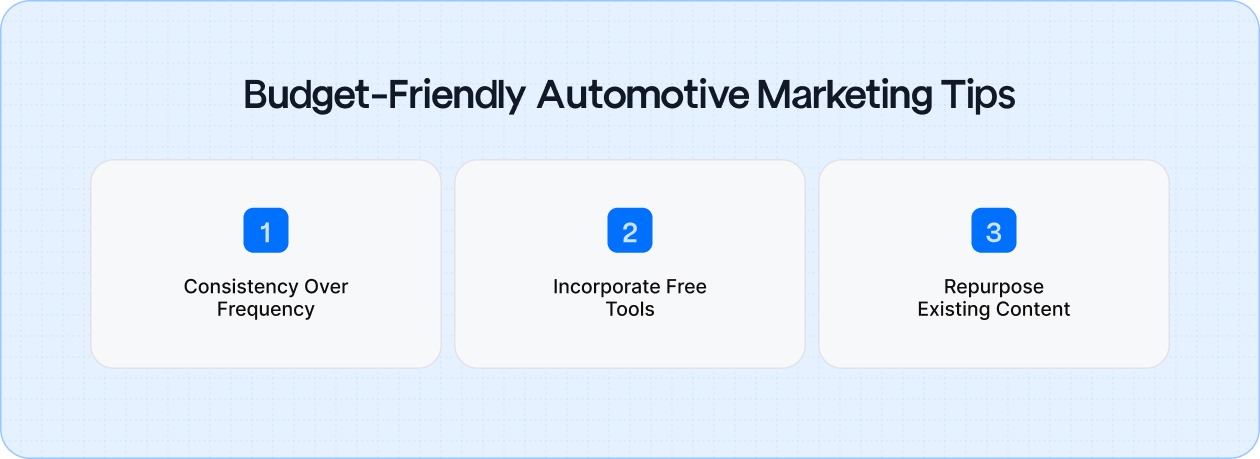
Content marketing doesn’t have to drain your resources. Even with a limited budget, there are smart strategies to make your efforts more impactful and keep your audience engaged. Here are a few cost-effective practices to help your automotive business succeed:
You don’t need to flood your audience with content every day. The key is to be consistent, not necessarily frequent. Regularly publishing valuable content, even if it’s less often, builds long-term engagement.
You don’t need expensive software to create high-quality content. Many free tools offer all you need to make your content stand out.
Recycling content allows you to get more value from each piece you create. Repurposing saves time and helps you reach wider audiences across different platforms.
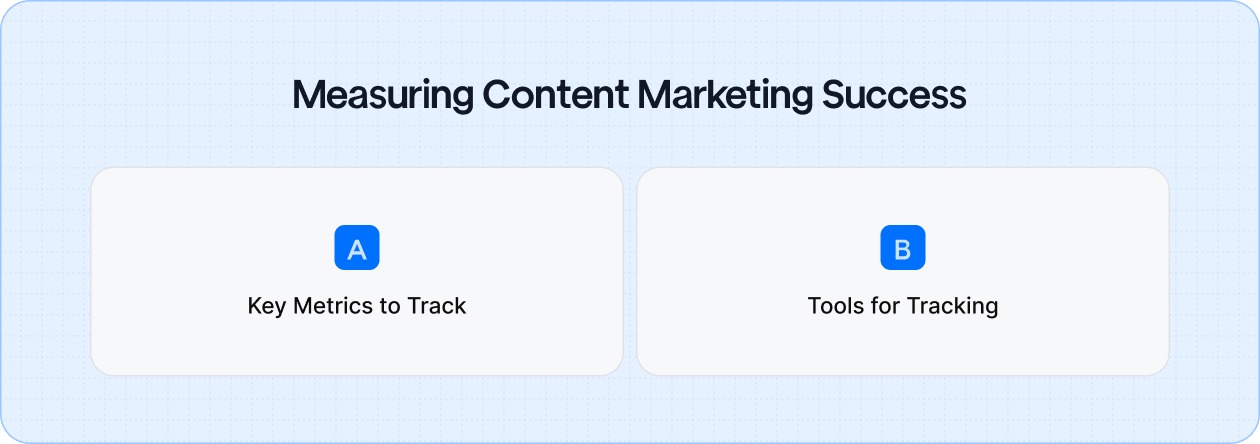
Tracking the right metrics is essential to understanding how well your content is performing and where adjustments are needed. By focusing on key areas, you can stay on top of what works and what doesn’t, making it easier to refine your strategy.
While these tools provide a good start, the real impact comes when you have a strategy that adapts to the data. The right content can resonate more deeply with your audience when it's continuously fine-tuned and optimized based on real-time insights. With the right guidance, you'll get more from every piece of content you create.
For automotive SMBs and startups, content marketing is a pathway to meaningful connections and sustainable growth.
By focusing on educational content, video marketing, and building genuine customer relationships, you can drive engagement and attract the right audience without the need for a huge budget.
Even small, strategic efforts can lead to significant, long-lasting results.

If you’ve been thinking about starting a lawn care business, the first question that usually hits is, “How much is this actually going to cost me?”
It’s a fair question. The numbers online can feel all over the place, and it’s hard to know what you truly need on day one versus what can wait until you have steady clients.
You can start small and grow steadily, as long as you understand where your money goes and why.
In this blog, you’ll learn exactly what makes up the start-up cost for lawn care business, how much to budget for each part, practical cost scenarios and simple ways to keep your expenses under control.
Your costs depend heavily on the type of operation you want to build. Some owners start small to keep things manageable. Others plan for a full-time route or a multi-crew setup from day one.
Understanding these business types helps you choose the path that fits your goals and budget without overspending:
This is the simplest and most affordable way to enter the industry. You focus only on mowing, trimming and basic cleanups.
Cost impact:
This setup fits anyone starting part-time or wanting to test the market with low risk.
This includes mowing plus add-ons like edging, debris cleanup, mulch installation and small landscape touch-ups.
Cost impact:
This path creates higher earning potential but still keeps costs manageable.
Businesses that offer weed control, fertilization or pest treatments need special chemical-handling licenses and safety gear.
Cost impact:
This model earns well but has more upfront requirements.
These businesses target commercial properties, large estates or HOAs that need regular, high-volume service.
Cost impact:
This setup costs more but offers stable recurring contracts that can scale fast.
Designed for owners who plan to hire and manage multiple workers.
Cost impact:
This approach requires more investment but creates the highest earning ceiling.
Gushwork helps you build clear content and choose the right keywords so homeowners discover your business the moment they start searching.
Starting a lawn care business can feel overwhelming when you first look at the numbers, but once you break the costs into simple parts, it becomes much easier to plan.
Here’s what each part costs, why it matters and how to decide what level of expense makes sense for your goals:
Your equipment is what determines how many lawns you can handle in a day and how reliable your work will be. It’s also the category where most new owners overspend or under-spend.
What you truly need to start:
What the cost looks like:
How to choose: Start with equipment that matches the number of lawns you realistically expect to service per day. If you plan on handling 6–12 lawns daily, invest in commercial-grade tools. If you plan to keep it to a handful per week, start small and upgrade once money comes in.
Your tools need a safe, reliable way to move from one lawn care job to the next. This is a cost that surprises many new owners.
Your main choices:
Cost ranges:
How to choose: Think about how far you’ll drive, how heavy your gear is and whether you plan to hire help. A simple trailer and personal vehicle hack works surprisingly well for early stages and keeps costs low.
This part isn’t exciting, but it’s what keeps you safe legally and financially.
What you need at minimum:
Cost ranges:
Even the best lawn care setup won’t help you if nobody knows you exist. Marketing doesn’t need to be expensive, but it does need to be clear and consistent.
Where your early marketing money goes:
Cost ranges:
How to choose: Get your Google Business Profile done first. This alone brings in steady local calls once it’s set up correctly. A simple website is your next best investment.
You’ll need a way to schedule jobs, send invoices and track payments. Keeping this simple in the beginning saves time and stress.
Cost ranges:
This is the money that keeps things running when your mower breaks, your truck needs gas or a week of rain slows everything down.
Cost ranges:
Starting a lawn care business doesn’t have to drain your savings. With the right choices, you can launch confidently while keeping your spending under control. These tips help you avoid common money traps and focus on the things that actually matter when you’re just getting started.
When you approach your startup cost with clarity, you give yourself room to grow at your own pace. Some people begin with the basics and build slowly. Others choose a stronger setup from day one so they can take on more work. Both paths work as long as the decisions match your goals, your budget and the kind of business you want to run.
Over time, steady customers, recurring routes and smarter equipment choices will shape the business into something stronger than where you started.
With a clear plan and a grounded understanding of your true costs, you’re already ahead of most new owners stepping into this industry.

Walk into most furniture stores, and you’ll see the same thing: beautifully arranged products, perfect lighting, and a team ready to help. But online? Many of those same stores look nothing like the experience they offer in person. Pages feel unfinished. Product info is thin. Navigation feels confusing. And search engines struggle to understand what the store actually sells.
This disconnect is the real SEO problem in the furniture industry.
SEO is about translating the quality, style, and care customers see in your showroom into a digital experience that search engines and shoppers can recognize.
In this guide, we’ll go through the best SEO practices that help furniture stores reflect their true value online and turn website visits into store visits, enquiries, and sales.
Furniture SEO is the process of helping your furniture business show up when customers search online for the products you sell, whether that’s sofas, dining sets, wardrobes, office chairs, beds, outdoor furniture, or anything in between. It puts your brand in front of shoppers at the exact moment they’re researching and ready to buy.
Here’s why furniture SEO works differently and why it matters for your business:
Customers switch between Google, Instagram, Pinterest, marketplaces, and your website several times before making a decision. SEO ensures you appear every time they search again.
From “L-shaped sofa near me” to “TV unit design with price,” SEO influences both online orders and in-store footfall.
Clean images, specifications, material details, price ranges, delivery timelines, and reviews help you rank better and close more sales.
People prefer stores that deliver fast, offer assembly, or have a showroom they can visit. SEO helps you capture these ready-to-buy customers, especially the local ones.
SEO for furniture manufacturers brings more qualified customers to your store, boosts enquiries and showroom visits, and increases daily sales without increasing your ad budget.
Furniture SEO works best when all the core parts of your website and online presence are set up the right way. Every area below plays a different role, but they work together toward one goal: helping shoppers find your products faster, understand them clearly, and feel confident enough to visit your store or place an order:
On-site SEO focuses on how your website is organized. When your pages are arranged in a clean structure, search engines understand your products better and show them to the right shoppers. This improves both visibility and user experience.
What to do
Product pages are where most search visitors land. They must be detailed and easy to understand. When a shopper can see the size, material, photos, price, and delivery info without hunting for it, they stay longer and buy more. Search engines also prefer well-structured product pages because they answer real customer questions.
What to do
Category pages are where shoppers browse before choosing a product. A proper category layout with helpful filters makes their search easier and signals to search engines what the page is about. Strong category pages improve both user experience and SEO performance.
What to do
If you have a physical showroom, local SEO is essential. It helps people nearby find your store when they search for “furniture near me” or look for directions, stock availability, or store hours. A strong local presence drives real foot traffic and increases in-store sales.
What to do
Suggested read: 7 Essential SEO Tips for Suppliers to Boost Your Online Visibility
Helpful content removes guesswork and guides customers toward the right choice. It also signals to search engines that your site answers real customer questions, which improves visibility.
What to do
Technical SEO focuses on how well your site works behind the scenes. A slow or confusing site makes customers leave before they even see your products. Fixing technical issues helps your pages load faster, improves the shopping experience and gives search engines a cleaner site to rank.
What to do
Link building is getting other trusted websites to mention or link to your store. These links act like signals that your business is real and reliable. Furniture stores don’t need hundreds of links. A few strong, relevant ones can meaningfully improve your visibility and bring new shoppers your way.
What to do
Paid advertising helps you reach shoppers immediately while your SEO builds long-term traffic. These ads place your products and store in front of people who are actively searching for furniture. When used properly, paid channels bring steady visibility and complement your organic efforts.
What to do
KPIs are the numbers that show whether your SEO is helping your business grow. Instead of tracking every metric, focus on the ones tied to real actions like calls, store visits, and sales. These tell you exactly what’s working and where to improve.
What to track
Great furniture stores succeed because customers can see, feel, and trust the value of what you offer. Your website needs to do the same. With the right SEO practices, your online presence stops feeling like a weaker version of your store and starts becoming a strong sales tool on its own.
Better structure. Clearer product pages. Smarter keywords. Faster load times. These improvements shape how shoppers perceive your brand before they ever walk through the door.

What makes a homeowner feel confident enough to call a foundation repair company? Often it’s a simple mix: clear answers, visible proof, and the sense that this company knows the neighborhood and the problem. When those elements line up, a search turns into a phone call.
Good SEO creates that feeling of safety. It makes your business easy to find in the exact moment someone starts worrying about cracks, sinking floors or shifting walls.
In this blog, you’ll learn the core parts of foundation repair SEO, the strategies that help you bring in reliable local prospects, and the mistakes that quietly slow down growth.
If you run a foundation repair business, you want to make sure that when people need help with their foundation problems, they can easily find you. Foundation repair SEO helps you:
SEO is built on a few main components that help your business appear in local searches, earn trust, and attract homeowners who need reliable repair services. These components fall under different types of SEO, each serving a specific purpose in how your business is found and understood online.
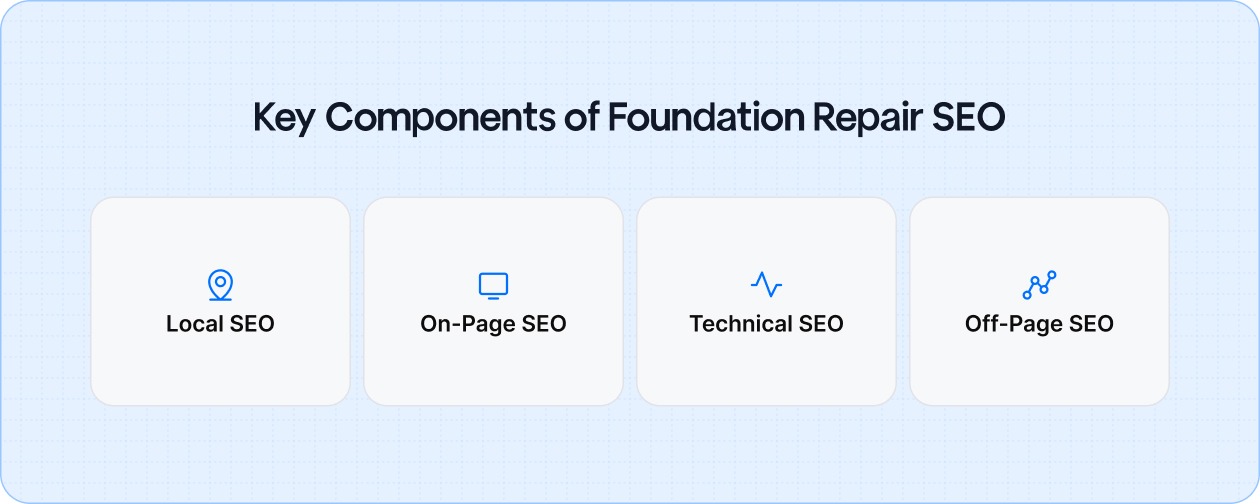
Local SEO focuses on helping your business show up when people look for foundation repair in their city. This includes how you appear in Google Maps, local search results, and nearby service listings.
Key elements of Local SEO:
Local SEO makes you more discoverable in your own market and helps you rank in local searches.”
On-page SEO is about what lives on your website and how clearly it explains your services to both customers and search engines. This helps search engines understand your expertise and match you to the right searches.
Key elements of On-Page SEO:
On-page SEO improves your business's visibility when searched for specific terms like “slab repair,” “crack inspection,” or “crawl space leveling.”
Technical SEO covers the behind-the-scenes structure that helps your website load fast, work smoothly, and perform well on all devices. This ensures both search engines and visitors can access your content without issues.
Key elements of Technical SEO:
Technical SEO gives your site the foundation it needs to rank well and keep visitors engaged, and tools like PageSpeed Insights help you identify performance issues that could be holding your site back.
Off-page SEO refers to signals that happen outside your website but influence your reputation and authority. These signals help search engines understand whether your business is trusted in your industry and your community.
Key elements of Off-Page SEO:
Off-page SEO strengthens your credibility and supports long-term rankings.
These strategies turn your core SEO elements into real growth. Each strategy includes a clear explanation of why it matters and direct actions you can start right away:
Your Google Business Profile is often the very first place a worried homeowner sees your business. It’s the listing that shows your reviews, photos, hours and service area right on Google Maps. If it looks complete and active, people trust you. If it looks empty, they move on.
Goal: Get more map visibility and direct calls.
Actions:
People don’t search for “general foundation repair.” They search for the problem they see: cracks, sloping floors, sticking doors, sagging corners. If you have a page that speaks directly to that issue, they stay longer and trust you more.
Goal: Rank for high-intent searches that lead to inspection bookings.
Actions:
Foundation issues are often connected to local soil, weather and home types. When your content mentions real conditions from specific towns you serve, homeowners feel understood and Google recognizes your business as locally relevant.
Goal: Appear in neighborhood-level searches and show you’re a trusted option nearby.
What to do:
Schema is simple code added behind the scenes that tells Google exactly what your business does. You never see it, but Google reads it to better understand your services, reviews and service areas.
Goal: Help Google show richer information about your business and improve clarity.
What to do:
A homeowner dealing with wall cracks or sinking floors does not want to scroll through a slow or confusing website. If your site loads quickly and feels clean on a phone, they’re more likely to call you immediately.
Goal: Keep homeowners from leaving your site before they even read your content.
What to do:
Nothing builds confidence like seeing actual problems you’ve fixed. Homeowners want proof that you’ve handled jobs like theirs, especially when dealing with structural issues.
Goal: Show real-world experience and help customers feel safe choosing you.
What to do:
Local relationships are powerful in foundation repair. Realtors, home inspectors, contractors and property managers frequently deal with homeowners facing settlement or moisture issues.
Goal: Earn mentions and referrals that help your ranking and reputation.
What to do:
Foundation repair decisions are often emotional and expensive. Homeowners rely heavily on reviews to feel sure they’re choosing someone honest and skilled. Review activity also strengthens your ranking in local search.
Goal: Increase trust, improve click-through and support higher rankings.
What to do:
Search ads help you reach people the moment they decide to look for foundation repair. Many homeowners search only when they’re worried, so ads help you catch high-intent prospects while organic SEO builds in the background.
Goal: Generate inspection requests quickly and fill gaps in slow seasons.
What to do:
SEO works best when you know what’s bringing real results. Tracking helps you see which pages, ads or locations bring actual inspections and which ones are wasting budget.
Goal: Spend less money guessing and more money on what works.
What to do:
Here are the most common issues and how to avoid them:
Growing a foundation repair business online comes down to clarity. When your services are easy to understand, easy to trust, and easy to find, homeowners feel confident choosing you. SEO creates that clarity long before anyone reaches out.
With the right setup and consistent presence where local customers search, your business reflects the quality of your work. From there, SEO stops feeling complicated and starts supporting steady growth every day.





.svg)
.svg)
.svg)